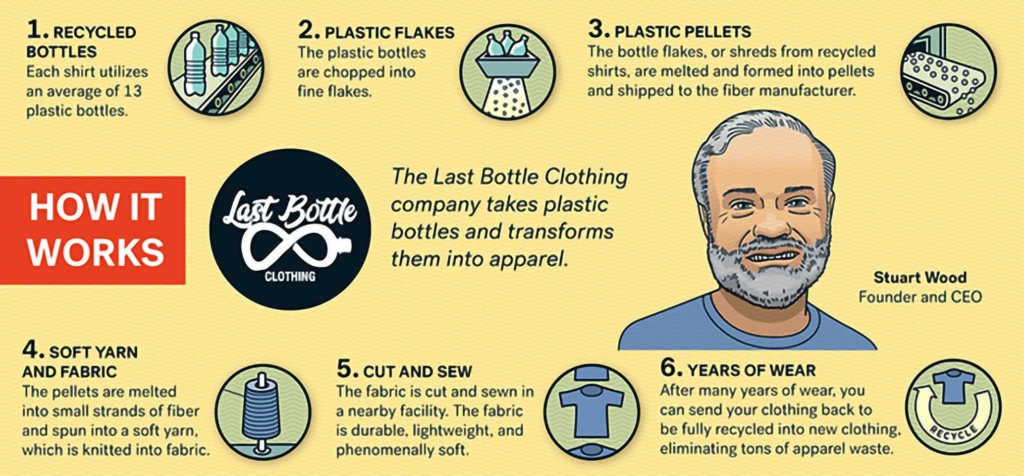At Last Bottle Clothing, Stuart Wood ’97 is making T-shirts out of plastic bottles and trying to shake up the apparel industry.
Making a comfortable T-shirt out of plastic bottles was more difficult than Stuart Wood ’97 expected. Although he thought the process of research and development for his start-up, Last Bottle Clothing, would take about a year, it ended up taking three. Some early attempts at fabrics were soft but fell apart in the wash. Others were durable, but “Let’s just say you wouldn’t want to wear it around for too long,” Wood says.
He wouldn’t give up, though, because at stake was more than a scratchy shirt. Wood hopes that his young company will help force the entire apparel industry to become more sustainable.
The problem of plastic pollution has been on Wood’s mind for decades. While he was at Colgate in the ’90s, his parents were living in Southeast Asia, and he did a lot of traveling in that region. Everywhere he went, he saw discarded plastic shopping bags and bottles. “I’ve always noticed it and been concerned about it,” he says.

One way to keep plastic out of the environment is to incorporate plastic waste into clothing. Some products, like polar fleece, already do this. But if your fleece jacket ends up in the garbage eventually, “What’s the point?” Wood says. Those plastic bottles had only a temporary reprieve from the waste stream.
That’s why, when Wood left his corporate job in 2015, he wanted to start a different kind of company. If he could manufacture clothing out of plastic, then recycle the clothing itself into more clothing, the plastic could theoretically stay out of landfills or oceans forever.
Wood and his business partner, Justin Koehn, founded Last Bottle Clothing in 2016. After the early days spent testing flimsy or downright painful T-shirts, they eventually found a formula for fabric that was both durable and soft.
The raw material is plastic bottles, mostly from municipal recyclers. In factories, the bottles are cut up and melted down into a material called flake. That’s made into thin fibers about an inch and a half long, similar to cotton fibers. Machines spin those fibers into thread and weave them into a cloth that, Wood says, feels just like your softest cotton tee.
Used shirts can go back to the beginning of the process. “We can chop up the shirts and mix them back in with those recycled bottles and put it right back through the supply chain,” Wood says. “We’re making closed-loop apparel.”
As the Last Bottle team started selling their shirts to customers, though, they realized that closing that loop in real life might be harder than they’d anticipated. People might not remember to recycle clothing they bought years earlier.
So, in 2019, the team decided to pivot and focus on selling directly to corporations that have uniform programs. A company can regularly collect worn-out shirts from its employees and send them back to be recycled. In this way, Wood hopes they can recapture nearly all of the plastic in the clothing.
That’s not the only way Last Bottle is treading lightly on the environment. The process of making cloth from bottles uses a tiny fraction of the water that goes into growing cotton, Wood says, and none of the pesticides. Perhaps most significantly, the company only uses suppliers within an approximately 200-mile radius of its headquarters in Georgia. That gives the T-shirts a tiny carbon footprint compared to most clothing, which travels around the world to reach American consumers.
“We’re still a relatively young start-up,” Wood says. He and his team are looking to add investors and scale up their business.
He says his goal, though, isn’t necessarily to make the business as big as possible, but to put pressure on the highly polluting, carbon-intensive apparel industry as a whole.
Looking at the planet today, “We can’t bequeath what we currently have to our kids, or to our grandkids,” Wood says. But he dreams of making his company competitive enough that the world’s apparel giants start shrinking their own environmental footprints. If that happens, he says, “We can have an impact that is far greater than us.”
